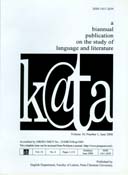Chinese as a Cultural Capital: The Case Study of Chinese Heritage Language Learners
Abstract
Chinese language education in Indonesia is closely related to the social, political, and cultural dimensions of the country. The change of power in the country in 1998 affected the development of Chinese language. Since the ban imposed on Chinese language and culture since 1965 was lifted, there have been an increasing number of Chinese language schools. Under the theoretical frameworks of Gardner’s motivational orientations and Bourdieu’s cultural capital, this study explored varied motivations of Chinese Indonesians to learn Chinese, and how their perception of China influenced their efforts in learning the language. Data were obtained through focus group discussions and interviews. The findings showed that integrative and instrumental orientations were found among participants, but due to the learners’ social milieu, instrumentality of Chinese dominated their orientations. The instrumentality of Chinese and the positive perception of China worked together to make Chinese language as a cultural capital for these CHL learners.
Downloads
References
Bakhtin, M. M. (1991). The dialogic imagination: Four essays. C. Emerson & M. Holquist, trans. M. Holquist, (Ed.). Austin: The University of Texas Press.
Bourdieu, P. (1986). Forms of capital. In John G. Richardson, (Ed.), Handbook of theory and research for the sociology of education (pp. 241-258). New York: Greenwood Press.
Bourdieu, P. (1991). Language and symbolic power. J. B. Thompson, et al., trans. Cambridge: Polity Press.
Chen, N. (2017, November 6). 16 ge sheng 8397 kaosheng canjia Yinni quanguo 2017 nian 10 yuefen Hanyu kaoshi shengkuang huigu [8397 Candidates from 16 provinces across the country participated in the Indonesian national Chinese language examination in October 2017]. Qiandao Ribao, p. 17.
Chen, Y. (2005). Zai yi Yinni huawen jiaoyu de xianzhuang he weilai fazhan [Revisiting current situation and future development of Chinese language education in Indonesia]. In R. L. Lin, et al. (Eds.), Di san jie Yinni huawen jiaoyu yantaohui lunwen xuanji (pp. 7-16). Jakarta: Yinni Yajiada Huawen Jiaoyu Xietiao Jigou.
Gardner, R. C. (2001). Language learning motivation: The student, the teacher, and the researcher. Texas Papers in Foreign Language Education, 6(1), 1-18.
Hall, J. K., Cheng, A., & Carlson, M. T. (2006). Reconceptualizing multicompetence as a theory of language knowledge. Applied Linguistics, 27(2), 220-240. doi: 10.1093/applin/aml013
Herlijanto, J. (2017). Public perceptions of China in Indonesia : The Indonesia national survey (ISEAS Perspective 2017 No. 89). Retrieved from ISEAS website: https://www.iseas.edu.sg/images/pdf/ISEAS_Perspective_2017_89.pdf
Hoon, C. Y. (2007, June 1). How to be Chinese. Retrieved from http://www.insideindonesia.org/how-to-be-chinese-2
Hoon, C. Y. (2011). Chinese identity in post-suharto Indonesia: Culture, politics and media. Portland: Sussex Academic Press.
Hummel, K. M. (2014). Introducing second language acquisition: Perspectives and practices. Malden, MA: Willey Blackwell.
Lu, X & Li, G. (2008). Motivation and achievement in Chinese language learning: A comparative analysis. In A. W. He & Y. Xiao, (Eds.), Chinese as a heritage language: Fostering rooted world citizenry (pp. 89-108). Honolulu: University of Hawai’i, National Foreign Language Resource Center.
Mandell, P. B. (2002). On the background and motivation of students in a beginning Spanish program. Foreign Language Annals, 35(5), 530-542. doi:10.1111/j.1944-9720.2002.tb02721.x
Masgoret, A. M, & Gardner, R. C. (2003). Attitudes, motivation, and second language learning: A meta-analysis of studies conducted by Gardner and associates. Language Learning, 53(1), 123-163. doi:10.1111/1467-9922.00227
Norris-Holt, J. (2001). Motivation as a contributing factor in second language acquisition. The Internet TEFL Journal, 8(6), 1-4.
Norton, B., & Toohey, K. (2011). Identity, language learning, and social change. Language Teaching, 44(4), 412-446. doi:10.1017/S0261444811000309
Shih, C. (2017). Introduction: China and Chinese migrant scholarship. In C. Shih (Ed.), Producing China in Southeast Asia (pp. 3–16). Singapore: Springer.
Sutami, H. (2007). Kekhasan pengajaran bahasa Mandarin di Indonesia. Wacana, 9(7), 222–237. doi:10.17510/wjhi.v9i2.214
Tong, C. K. (2010). Identity and ethnic relations in Southeast Asia: Racializing chineseness. New York, NY: Springer
Wen, X. (2011). Chinese language learning motivation: A comparative study of heritage and non-heritage learners. Heritage Language Journal, 8(3), 41-66.
Wen, X. (1997). Motivation and language learning with students of Chinese. Foreign Language Annals, 30(2), 235–251. doi:10.1111/j.1944-9720.1997.tb02345.x
Yang, J. S. R. (2003). Motivational orientations and selected learner variables of East Asian language learners in the United States. Foreign Language Annals, 36(1), 44–56. doi:10.1111/j.1944-9720.2003.tb01931.x
Zhang, N. (2015). Motivation of Chinese heritage language learners : From a bioecological perspective (Master’s thesis). Retrieved from https://docs.lib.purdue.edu/dissertations/AAI1598135/
Zhao, K. (2016). China’s rise and its discursive power strategy. Chinese Political Science Review, 1(3), 539-564. doi:10.1007/s41111-016-0027-x
Zong, S. & Liu, W. (2007). Yinni huawen jiaoyu zhengce de lishi yanbian ji qi zouxiang yuce [Historical change and trends of Chinese language educational policy in Indonesia]. Jinan Daxue Huawen Xueyuan Xuebao, 3(1), 1-18.

This work is licensed under a Creative Commons Attribution 4.0 International License.
![]() This work is licensed under a Creative Commons Attribution License
This work is licensed under a Creative Commons Attribution License




.png)
.png)

.png)












